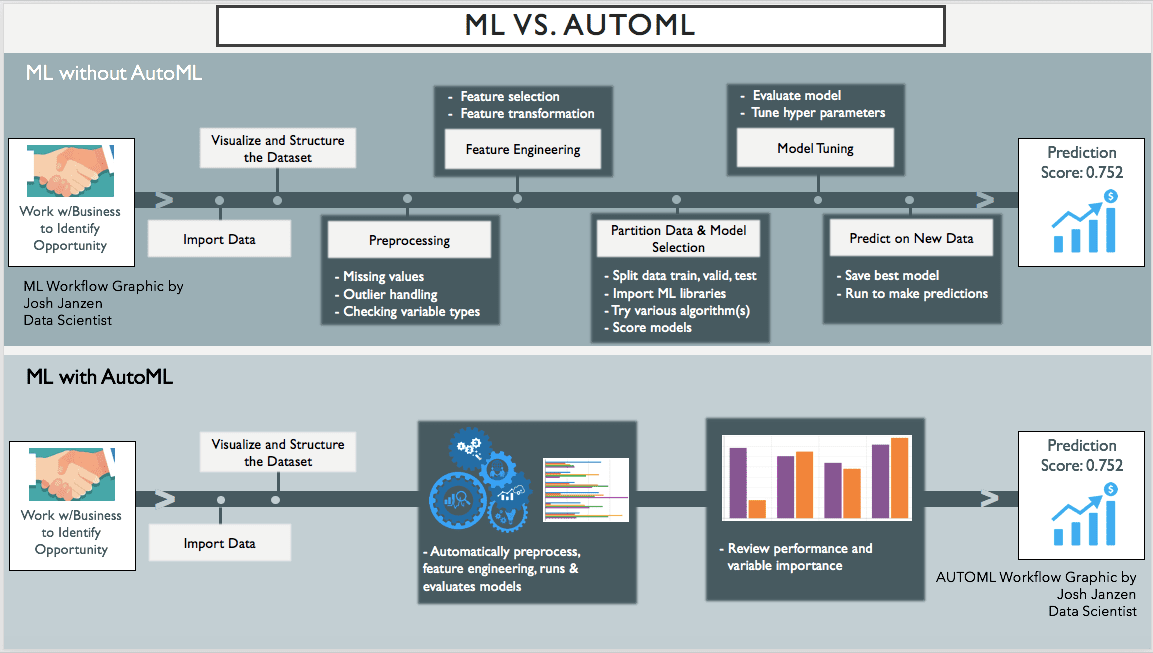No-code artificial intelligence wave is rolling over everyone and everything. All we can do is explore more facets of it, so here we go with the term AutoML. Gartner says the worldwide low-code development technologies market will grow by 23% in 2021, so you know you are not dealing with a fad. With each passing advancement in AI, we are getting closer to a sophisticated AI setup. We are sure you have heard of LaMDA by now.
We must remember that with AI evolving to be more human-like, we need more and more people who can understand the behavioral shift. Machine learning is becoming more accessible than ever before as the industry expands. The importance of artificial intelligence lies in its transformative ability to revolutionize industries, enhance decision-making processes, and drive innovation at an unprecedented scale. Artificial Intelligence (AI) software can offer numerous benefits to businesses across various industries. The first step toward simplifying machine learning involved developing simple, unified interfaces to various machine learning algorithms.

What is AutoML (Auto Machine Learning)?
Automated machine learning (AutoML) is a process of automating process of applying machine learning models to a real-world problem. Automating the machine learning process makes it more user-friendly and often provides faster, more accurate outputs than hand-coded algorithms.
AutoML reduces the time software, web, and mobile app developers take to put their models into production. We can also relate this concept to the democratization of machine learning: most AutoML tools convey a message of user-friendliness and openness, and overall, they welcome everyone.
At this point, we hope that while the computer takes care of the iterative, repetitive, and dull tasks, such as data cleaning, data packaging, models tweaking, app deployment, etc., we can focus on more meaningful steps and truly develop your potential.
It’s worth noting that plenty of AutoML tools including code generation tools are currently on the rise and that each can focus on different steps of the machine learning process for their automation.
No-code AI and AutoML: Are They Different?
Let’s have a look at the tools of no-code AI:
- Drag and Drop or Flow Builder tools
- AutoML
- Pre-trained APIs
- Transfer Learning Tools
- AI App & Dashboard Builders
As we can see, AutoML Code is just one type of no-code AI tool available, and more and more, we see these types of devices being combined into a single solution. Automation can significantly accelerate your work for model selection, data preparation, feature engineering, or hyper-parameter optimization. Organizations need to monitor, manage, govern, and analyze the results of the ML models to ensure that they are meeting their business needs.
No-code ML is a subset that tries to make ML more accessible. No-code ML involves adopting a no-code development platform with a visual, code-free, and frequently drag-and-drop interface to deploy AI and machine learning models. Non-technical people may quickly classify, evaluate, and develop accurate models to make predictions with no code ML.
Difference Between Machine Learning and AutoML
In essence, AutoML and no-code AI are not two separate entities but interlinked. However, there is a diverging difference between machine learning and automatic machine learning. The following figure elaborates:

As you can see, these platforms usually consist of four types of automation tasks:
- Data Ingestion & Data Exploration
- Data pre-processing, Feature Engineering, and Feature selection
- Model training and Hyperparameter optimization
- Model Evaluation and Interpretation
AutoML and No-code AI: Commons and Differences
AutoML and No-code AI platform tools converge and diverge at specific points, despite being interlinked, and we are here to study it. Being open to everyone, no-code ML has become this giant umbrella under which anyone can call themselves a “coder.”
Okay, that may be a bit exaggeration of the facts, but it feels like that on some levels. It is because both these platforms hide the complexity linked to the job of programmer or data scientist under the hood.
They do this by providing user-friendly interfaces, drag-and-drop, or one-button actions instead of lines of code and out-of-the-box presets that have been neatly prepared to be as efficient as possible. This makes for an immersive and (hopefully) intuitive experience that even non-experts can dive into without the fear of gigantic concepts being lost on them.

Be careful using AutoML Though!
World has become a hub for AI and ML research, development, and implementation. Understanding the domain of your project and the data is one of the most critical aspects of any Machine Learning solution. That’s why Subject Matter experts play such a significant role, and most of the time, they don’t have the Data Science Skills. AutoML tools, in theory, solve that problem because they allow anybody to build models without having the model development expertise. But don’t get confused. You still need the Model Interpretability skills, the Data skills, the feature skills, and if you are serious about putting your model into production, you also need Model Deployment skills.
Most Machine Learning use cases are too custom to fully automated, and SMEs are busy doing other tasks. Data understanding is usually done by Data Scientists having conversations and brainstorming sessions with multiple stakeholders. AutoML tools and No Code AI tools are very good at automating tasks but have difficulty understanding the business context.
Explainability also plays a significant role for AutoML. For example, if you automate the Feature Transformation steps, it is imperative to understand how those are done and which impact they will have. Those advanced capabilities are not always available in every tool.
ML vs. AutoML Graphics Copyright Courtesy: Josh Janzen




